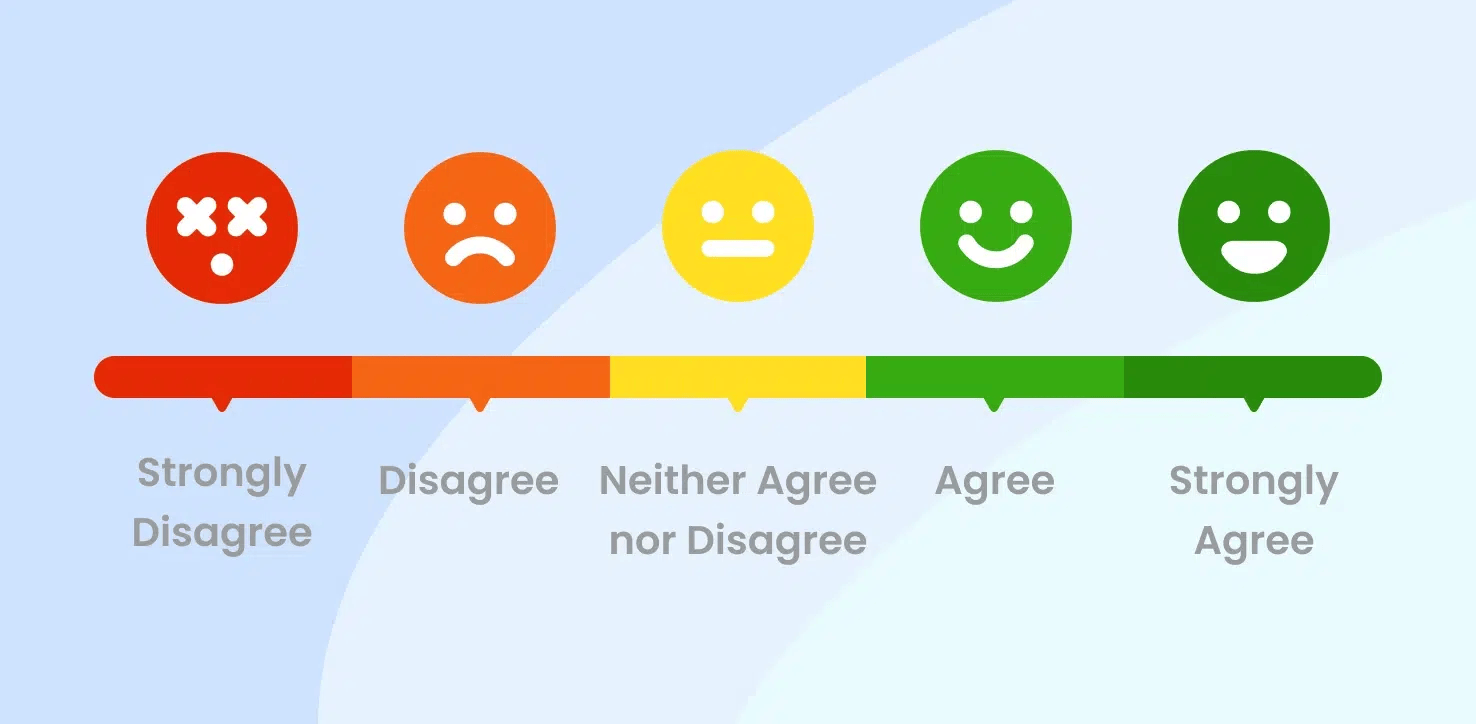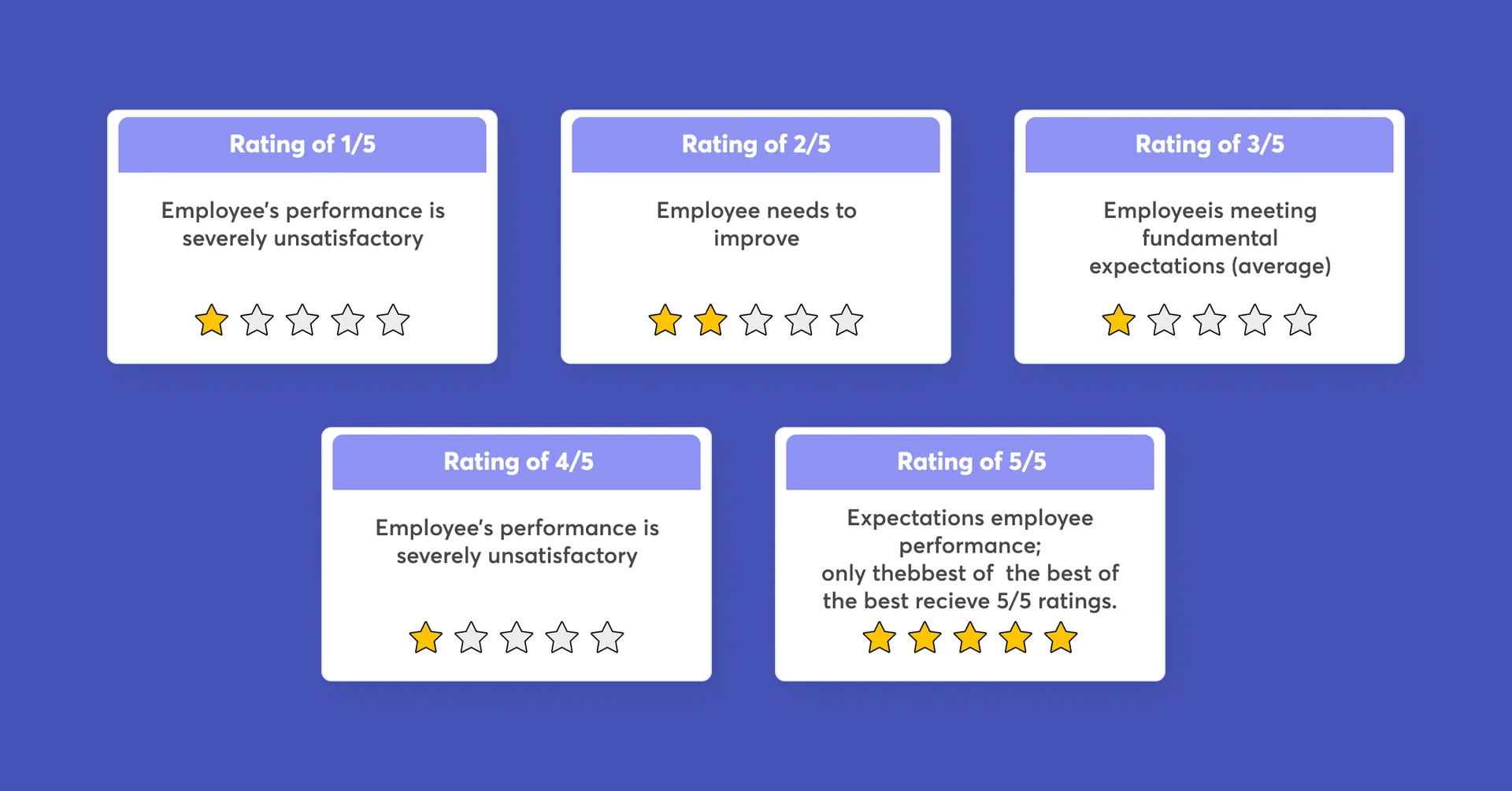There is often a questions put by HR that why employee rating scales are crucial for performance reviews? Below is the answer :
“No five fingers are alike” same is the case with your employees. Some employees perform extremely well and some need that extra push to meet deadlines.
But how to identify which employee stands where in terms of performance.
Here is when the employee rating scale comes into the picture.
The employee rating scales helps to measure employee performance quantitatively. It also allows you to get feedback from more employees in one review cycle, thus speeding up the review process.
Below we have listed widely used employee rating scales for performance review by organizations world wide.
Suggested read: Choose a continuous performance management software
What is employee rating?
Employee rating refers to the process of evaluating and assessing an employee’s performance, skills, and contributions within a workplace. It typically involves assigning a numerical or qualitative score to indicate how well an employee meets job expectations, achieves goals, and demonstrates competencies. Employee ratings are often used as a basis for performance reviews, feedback, promotions, and compensation decisions.
Why rating employee performance is important?
The answer is not as simple as understanding which employee is performing well and who needs improvement. Rather it is much more than that
According to research top-performing employees perform at 400% of the level of the rest of the company – yet without rating performance, the HR and managers will not be able to identify and act on these performance differences systematically.
Below are a few pointers that tell the importance of systematically rating the employee performance
- The decisions on promotions, salary hikes, and other opportunities should be done on basis of data. Rating employees’ performance will help you to maintain that data and take decisions accordingly. The lack of this data-driven approach will lead to inaccuracies when making decisions.
- With a proper employee rating system established around certain criteria, employees feel accountable towards what should be their performance level to get a raise, get promoted, or develop their skills.
- Well-designed and structured performance ratings help differentiate low-performing employees from high-performing ones and identify areas for improvement, and offer transparency in decision-making.
Suggested read: The 12 Most Effective Performance Evaluation Methods
Why are employee rating scales useful for performance reviews ?

The distance between number one and number two is always a constant. If you want to improve the organization, you have to improve yourself and the organization gets pulled up with you. – Indra Nooyi, Former Chairman & CEO Pepsico.
Employee performance rating scales are based on fixed matrics that vary according to the organization’s size and goals. But, within organization, it is a simple comparison between the performance and dedication levels of employees.
This fixed matric makes it easy for you to rate all the employees on that fixed metric in the form of performance review ratings.
Below are the reasons why this employee rating scale is important:
- You can use an employee rating scale to identify outstanding performers in your organizations and award corporate rewards accordingly.
- By analyzing a worker’s overall rating score, you can get a solid understanding of said worker’s dedication and it will be easy for you to select the right candidate for a promotion.
- For example, if an employee resigns from the post for any reason, and you want to replace them with a candidate within the team. How will you select the best one? That’s when employee rating scales help you.
- Recording employee rating on an employee rating scale has many other benefits, including determining a worker’s raise, determining if he/she should be granted extended vacation leave, and making compensation decisions.
Performance Review Platform
Get a glimpse of how Peoplebox make performance reviews painless, actionable and fair
Which are the top 5 employee rating scales for performance reviews?
With so many employee rating scales options available, it is confusing to choose the right one. Remember, not all employee rating scales available in the market are good for your organization. Some are less effective than others, and some may be effective for other organizations but not be the right fit for your organization.
To help you out with this, below are the best 5 employee rating scales that are often used in hypergrowth organizations:
1. The Likert scale

The Likert scale can have five or more statement options.
Strongly Disagree – Disagree – Neither Agree nor Disagree – Agree – Strongly Agree are the most common options used in this scale.
A typical Likert scale has five options but it is up to the organizations to choose how many options they want to keep. It can be even seven or more, or even as less as three.
But, it is important to decide whether the organization wants to keep the numbers to odd or even.
If the options are in odd numbers, the central option is neutral, neither positive nor negative.
In even numbers of options, there’s no neutral option, so the respondent has to choose one side. And, it may be a forced choice.
Limitations of the Likert scale
- This scale offers a neutral option, implying that the reviewer has no point of view on the question asked.
- Some reviewers might just fill the review for sake of completing it without actually contributing anything significant to it.
- In the Likert scale, there is no straightforward method through which employees can be given a score which is another drawback of this scale.
- It will be difficult to generate an answer average unless the 5-point method was combined with the Likert scale.
2. 5-Point Performance Rating Scale

The Five-Point Performance Rating Scale, a widely adopted evaluation method, stands as one of the simplest yet effective tools in gauging employee performance. With its intuitive structure, this scale centers on assigning ratings from 1 to 5, each corresponding to a distinct performance level. The scale’s straightforwardness simplifies the assessment process while allowing room for nuanced distinctions.
Employee behavior is typically analyzed through a set of questions created by the reviewers. These questions might be directed at individual performance, teamwork skills, timely work submissions, or employee performance.
While the formulation of such questions varies based on organizational culture and domain, common questions arise are as follows:
- How consistently does the employee meet project deadlines?
- Is the employee adept at fostering teamwork?
- Is the employee attuned to their role’s significance within the company?
- Does the employee exhibit innovative thinking?
- Can the employee effectively train new colleagues?
- Does the employee emanate enthusiasm within the workplace?
- What rating would accurately mirror the employee’s work ethic on a scale of 1 to 5?
Limitations of the 5-Point Performance Rating Scale
- This scale largely depends upon an individual’s understanding of what each number means.
- Additionally, The meaning of “satisfactory” may differ between people, so this can cause problems during ratings. Some Manger provides a four-start rating to their subordinates instead of a five because his/her standards for perfection are too high, or some managers rate their subordinates at 3 for doing the bare minimum.
- It may oversimplify complex employee performance nuances, lacking granularity.
- The scale’s rigidity might not capture exceptional performance or minor improvement effectively.
- It can lead to biases, as a limited range might not accurately reflect variations in performance.
- The lack of specific criteria for each rating could result in inconsistent evaluations.
- It might not accommodate different performance dimensions, such as creativity or adaptability.
The solution to the above problem is to provide a key or standard reference metric to reviewers to develop a common understanding of what each number means.
3. Behaviorally Anchored Rating Scale (BARS)
A sophisticated performance evaluation method, BARS integrates behavior-focused descriptions of performance with numerical ratings. This fusion ensures a balanced approach, offering both qualitative understanding and quantifiable data for a more precise evaluation. However, developing and sustaining a comprehensive BARS system demands substantial time and effort.
Limitations
- The creation and implementation of BARS necessitate significant time, effort, and resources.
- Despite its structure, BARS can still be susceptible to evaluator bias, affecting the reliability of ratings.
- The complexity of BARS systems might require extensive training and understanding to ensure accurate evaluations.
- Keeping the behavioral descriptions updated and relevant requires consistent monitoring and adjustments.
- BARS may only suit some roles or industries, potentially leading to inaccuracies in certain evaluations.
4. The Graphic Rating Scale
The Graphic Rating Scale offers a fresh perspective on employee evaluation. Traits and competencies are graphically portrayed, accompanied by a numbered scale. Ranging from “extremely poor” to “excellent,” this visual spectrum enhances clarity in assessment. Notably, reviewers can augment feedback with specific comments, enriching the evaluation process. While these comments lack numerical attribution, their qualitative essence adds depth to the assessment. The Graphic Rating Scale merges visualization and precision, unveiling a modern approach to performance appraisal.
Limitations
- This scale’s reliance on qualitative descriptions can lead to subjectivity in interpretation, resulting in inconsistent evaluations.
- The graphic rating scale’s generalized labels like “good” or “excellent” can lack clarity, making distinguishing between various performance levels challenging.
- The predefined traits might only comprehensively capture some employee competencies, limiting the scale’s adaptability to diverse roles.
- While comments offer qualitative insights, they need more numerical weight, potentially diminishing their impact in comparative analysis.
- The absence of clear numerical values makes comparing employees across teams or time periods intricate, affecting fairness and objectivity.
5. Custom Scales
HR teams can create their own customized scales which fit their needs.
But, the most common risk associated with this scale is that it can lead to unexpected distortions in data.
Limitations
- Custom scales can inadvertently introduce varying degrees of subjectivity, impacting the consistency and fairness of evaluations.
- The absence of industry-standard metrics might hinder comparisons with other organizations or industry norms.
- Custom scales may complicate the process of aggregating and interpreting data, potentially leading to confusion or misinterpretation.
- The absence of established validation procedures for custom scales could compromise their reliability and validity.
- Implementing custom scales necessitates thorough training for evaluators to ensure accurate and unbiased assessments.
Below are a few tips you can use if you opt to create a customized rating scale for your organization.
Tips to create customized employee rating scales

1 Understand range and validity
The most important point that you should keep in mind while creating an employee performance rating scale is range and validity.
The traditional performance rating systems are generally weak in these two areas only.
Range: Traditional review methods don’t effectively differentiate and create any meaningful range.
If you find that all the employees are top performers in your organization this indicates leniency bias where your managers’ font know how to distinguish top-performing employees from the rest ones.
You can counteract this bias by designing a scale with multiple, well-defined responses for “above average” performance as well as training raters and running calibration sessions.
Validity. Coming to validity it is important to ask yourself a few questions like does the question and answers are relevant to the organization or do the organization really cares about those things? Will these ratings help drive better decisions based on what’s important?
2 Align your rating scale to your brand goals
It is imperative that your rating scale reflects your unique brand and business goals.
Depending on the criteria and behaviors that you’re trying to measure, you would customize the wording and design of your questions and response options accordingly.
Your raters will be able to use the scales more effectively and consistently if each response option description is more specific (i.e., “anchors”)
If the number of response options is more creating clear, differentiated descriptions becomes even more important.
To come to a decision and eliminate centrality bias you will have to eliminate “neutral” options on your scales.
3 Transparency is important
When there is no transparency around how employees are being measured, trust and perceptions of fairness are not built. One of the biggest mistakes you can make is to inform employees about the elimination of rating systems and use it behind closed doors with the executive and management teams.
How to choose a Suitable Rating Scale?

You can use the following tips to come up with a performance evaluation rating scale for your organization:
- Prepare a set of questions for the reviewer to answer. These questions should focus on the employee’s performance and commitment to the organization. Your questions must also be reasonable and answerable using the chosen scaling method.
- Keep in mind the end goals you want to achieve while creating the questions.
- Choose a rating scale that is suitable for your organization. You can choose the best one from the list that feels appropriate.
Elevate Performance Evaluation with Peoplebox
Choosing an appropriate employee performance evaluation rating scale is pivotal for accurate insights. This decision impacts objective setting, feedback culture, and overall growth. To enhance this process, consider harnessing the power of Peoplebox, a dynamic performance management platform.
With its array of features, including:
- Customizable rating scales
- 360-degree feedback
- Intuitive performance dashboards
Peoplebox empowers organizations to refine performance evaluation. From employee performance rating scales to performance evaluation systems, Peoplebox propels organizations toward holistic excellence. To know more, request a free demo.
Performance Review Platform
Get a glimpse of how Peoplebox make performance reviews painless, actionable and fair







